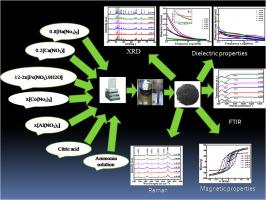Synthesis and characterization of Ni2+- Zr4+ doped Ba-Ca M-type hexaferrites using sol-gel auto-combustion method
IF 3.8
Q2 CHEMISTRY, PHYSICAL
引用次数: 0
Abstract
This work aims to study the effect of Zr-Ni dopant on the structure and traits of M-type barium calcium hexaferrites (BaCaM). For the first time, Ba0.8Ca0.2ZrxNixFe12–2xO19 (0.0 ≤ x ≤ 1.0) samples are synthesized employing the SGACM (sol-gel auto-combustion method). The pure phase formation of BaCaM was established by XRD data Rietveld refinement. An augmentation in both the lattice parameters (‘a’ as well as ‘c’) owing to the higher ionic radii of dopant ions as compared to Fe3+ shows that Ni2+and Zr4+ions were successfully swapped with Fe3⁺. The "c/a" ratio lies between 3.93–3.96 disclosing that the synthesized materials possess an M-type hexagonal ferrite structure. The reduction in crystallite with an increase in doping level might be due to lattice strain generated by the larger size of Ni2+ and Zr4+ dopant ions. The presence of two bands in the wavenumber range of 400 to 880 cm-1 in FTIR spectra corresponds to the Fe–O stretching in octahedral and tetrahedral locations. The Raman peaks widen without any shifting of the peak with an increment in Ni2+-Zr4+ ions contents revealing that Ni2+-Zr4+ are incorporated into BaCaM without changing its crystal structure. According to the M-H plots Ms value enhance from 24.94 (x = 0.00) to 36.84 emu/g (x = 0.60) and beyond x = 0.60, Ms values drop with an increment in Ni2+-Zr4+substitution level. A broad coercivity range lies between 4858 Oe (x = 0.0) to 653 Oe (x = 1.0), decreasing monotonically with substitution in Ni2+-Zr4+. All the synthesized material exhibits a reduction in dielectric constant value as frequency increases. Ni-Zr-doped BaCaM materials could be a suitable candidate for magnetic recording media and microwave absorber applications.

利用溶胶-凝胶自燃烧法合成掺杂 Ni2+- Zr4+ 的 Ba-Ca M 型六价铁氧体并确定其特性
这项工作旨在研究掺杂 Zr-Ni 对 M 型六价钡钙铁氧体(BaCaM)结构和性状的影响。该研究首次采用 SGACM(溶胶-凝胶自动燃烧法)合成了 Ba0.8Ca0.2ZrxNixFe12-2xO19 (0.0 ≤ x ≤ 1.0) 样品。通过 XRD 数据 Rietveld 精炼确定了 BaCaM 的纯相形成。由于掺杂离子的离子半径比 Fe3+ 大,因此晶格参数("a "和 "c")都有所增大,这表明 Ni2+ 和 Zr4+ 离子成功地与 Fe3⁺交换。c/a "比值在 3.93-3.96 之间,表明合成材料具有 M 型六方铁素体结构。随着掺杂水平的提高,结晶度降低,这可能是由于掺杂离子 Ni2+ 和 Zr4+ 的尺寸增大产生了晶格应变。傅立叶变换红外光谱中波长范围为 400 至 880 cm-1 的两条带分别对应于八面体和四面体位置的 Fe-O 伸展。拉曼峰随着 Ni2+-Zr4+ 离子含量的增加而增宽,峰值没有发生任何移动,这表明 Ni2+-Zr4+ 在 BaCaM 中的掺入并没有改变其晶体结构。根据 M-H 图,Ms 值从 24.94(x = 0.00)增加到 36.84 emu/g(x = 0.60),超过 x = 0.60 后,Ms 值随着 Ni2+-Zr4+ 替代水平的增加而下降。矫顽力范围在 4858 Oe(x = 0.0)到 653 Oe(x = 1.0)之间,随着 Ni2+-Zr4+ 取代度的增加而单调下降。所有合成材料的介电常数值都随着频率的增加而降低。掺杂 Ni-Zr 的 BaCaM 材料可能是磁记录介质和微波吸收器应用的合适候选材料。
本文章由计算机程序翻译,如有差异,请以英文原文为准。
求助全文
约1分钟内获得全文
求助全文
来源期刊

Chemical Physics Impact
Materials Science-Materials Science (miscellaneous)
CiteScore
2.60
自引率
0.00%
发文量
65
审稿时长
46 days
 求助内容:
求助内容: 应助结果提醒方式:
应助结果提醒方式:


